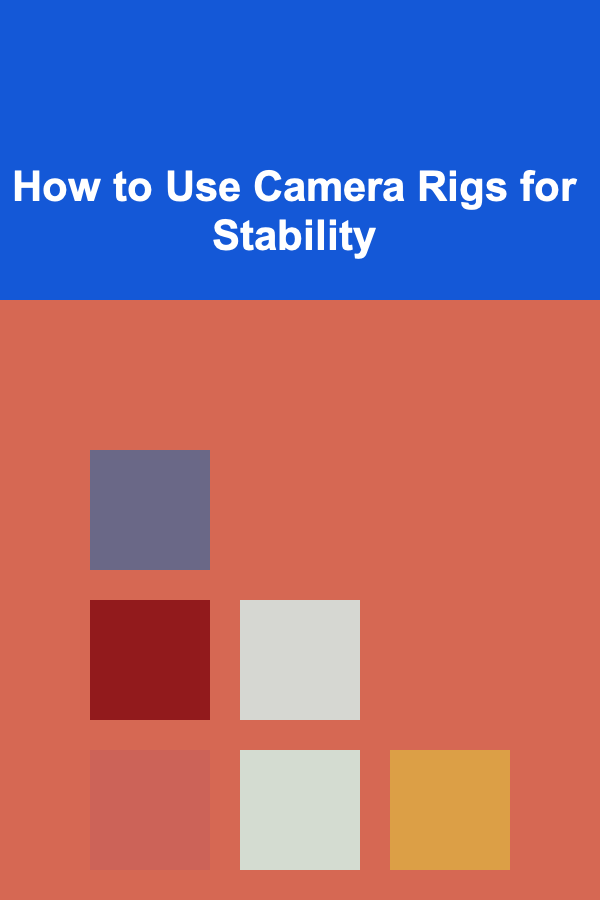
How to Use Camera Rigs for Stability
ebook include PDF & Audio bundle (Micro Guide)
$12.99$11.99
Limited Time Offer! Order within the next:

In the world of filmmaking, photography, and content creation, stability is key. Whether you're shooting a high-speed car chase or a serene landscape, smooth, steady footage makes a huge difference in the final product. A crucial tool in achieving this stability is the camera rig. Camera rigs are essential equipment for filmmakers, videographers, and content creators who require precise control over their camera's movement. These rigs can help minimize shakes, jitters, and unwanted movement, leading to more professional-looking footage.
In this article, we will explore how to use camera rigs for stability, the different types of rigs available, their functionalities, and how to get the best out of them. By the end of this guide, you'll be able to understand the importance of camera rigs in achieving a smooth and stable shot and learn the best practices for using them effectively.
What is a Camera Rig?
A camera rig is a piece of equipment designed to support and stabilize a camera, making it easier to shoot smooth footage. Rigs can range from simple handheld devices to complex systems that allow for versatile camera movements and angles. At its core, a camera rig's purpose is to isolate the camera from unwanted motions, which helps achieve fluidity in shots.
Camera rigs are used in many scenarios, such as:
- Handheld shooting: When you're shooting without a tripod, a camera rig helps reduce camera shake.
- Tracking shots: For following a subject or creating a sweeping motion, rigs allow for controlled, smooth movement.
- Steady-cam shots: These rigs enable you to capture fluid shots while moving through spaces or crowds.
- Aerial shots: With drone-mounted rigs or gimbals, you can shoot stable footage in mid-air.
Understanding the various types of camera rigs and how to use them will help you take your content to the next level.
Types of Camera Rigs
There are several types of camera rigs available, each designed for specific purposes. Some are handheld, while others are designed to be mounted on various surfaces or worn on the body. Here are the most common types:
1. Handheld Camera Rigs
A handheld camera rig is the simplest and most common type of rig. It's designed to be carried by the operator, who holds the rig and the camera to shoot footage. These rigs can be lightweight and compact, but they provide a more stable shooting experience than simply holding the camera in your hands.
Handheld rigs are often equipped with:
- Shoulder pads: To distribute the weight of the camera evenly, reducing fatigue during long shoots.
- Handles: To allow the operator to hold the rig comfortably and maintain control over the camera.
- Counterweights: To balance the rig and prevent unwanted tilting or swinging.
A handheld rig can significantly reduce camera shake compared to holding the camera alone, especially during dynamic movements like running or walking.
2. Shoulder Rigs
Shoulder rigs are designed for maximum comfort and stability during long shoots. These rigs rest on the shoulder of the operator, distributing the weight of the camera and helping the user maintain control. The shoulder rig allows for more freedom of movement while providing additional stability compared to handheld rigs.
Some key features of shoulder rigs include:
- Cushioned shoulder pads: These pads provide comfort and reduce strain, even when using heavier cameras.
- Adjustable rods: These rods help customize the rig's position based on the operator's body size and shooting preferences.
- Follow focus systems: These are often attached to shoulder rigs to allow for precise control over the camera's focus while shooting.
Shoulder rigs are ideal for filmmakers who need to move quickly but still require stability during handheld shooting, especially for mid-range shots.
3. Gimbals
Gimbals are electronic stabilization devices that use motors to balance and stabilize the camera along multiple axes. A gimbal typically consists of three main parts: the handle, the camera mounting platform, and the stabilizing motors. Gimbals are known for their ability to produce super-smooth, cinematic shots even when the operator is moving.
There are two types of gimbals:
- Single-axis gimbals: These stabilize the camera along one axis (typically pitch).
- Three-axis gimbals: These stabilize the camera along three axes (pitch, roll, and yaw), offering even more precise stabilization.
Gimbals are popular in both handheld shooting and on drones. They allow filmmakers to capture smooth footage while walking, running, or even flying through the air.
4. Steadicams
Steadicams are mechanical rigs that use a combination of springs, gimbals, and counterweights to stabilize a camera. They are typically worn by the operator, who holds the rig's arm, which is connected to a vest worn on the body. Steadicams are highly effective at producing smooth, stable shots while allowing for dynamic movements.
Steadicams are often used in action scenes or any scenario where the camera must move through difficult terrain while maintaining fluidity. They can be more complex and require proper training to operate effectively.
5. Dolly and Track Rigs
A dolly is a wheeled platform that holds the camera and moves along a set of tracks. Dolly rigs provide smooth, controlled horizontal movement, making them ideal for capturing steady, sweeping shots. They are often used in film studios or on location where precise camera movement is required.
Dolly rigs come in various forms:
- Manual dollies: Operated by pushing or pulling the rig along tracks.
- Motorized dollies: These rigs use motors to drive the movement of the dolly, allowing for more consistent and automated movement.
Track and dolly systems are commonly used in professional filmmaking, where complex camera movements and steady shots are required.
6. Drone Rigs
Drone rigs involve mounting a camera on a drone to capture aerial shots. While drones themselves have built-in stabilization, attaching an external camera rig can improve stability and provide greater control over the shot. These rigs are often used in both professional filmmaking and real estate photography to capture sweeping views from above.
Drone rigs work in combination with advanced gimbal systems to stabilize the camera as the drone moves through the air.
How Camera Rigs Improve Stability
Stability is essential in filmmaking, and camera rigs are the solution to achieving steady shots. Here's how camera rigs contribute to greater stability:
1. Reducing Handheld Camera Shake
When shooting handheld, the camera is susceptible to shakes from the operator's hands, body movements, and environmental factors like wind. A camera rig helps reduce these shakes by providing a better grip and distributing the weight more evenly. By holding the rig with both hands, the operator gains more control, leading to steadier footage.
2. Absorbing and Counteracting Motion
Camera rigs, especially shoulder rigs and steadicams, absorb and counteract motion from the operator's body. For example, when the operator walks or runs, the rig's system of counterweights and springs helps stabilize the camera. The camera is isolated from the movements of the operator's body, leading to smooth and fluid shots.
3. Providing Controlled Movement
With rigs like gimbals, you can precisely control the camera's movement along different axes. This allows for smoother and more intentional movements, like following a subject or creating a slow, sweeping motion across a scene. With gimbals or steadicams, you can make adjustments in real time, ensuring that the camera remains stable and fluid throughout the shot.
4. Balancing Heavy Cameras
For professional cameras, which can be quite heavy, balancing the weight on a rig is essential. A properly balanced camera rig distributes the weight of the camera evenly across the operator's body or the rig's platform, making it easier to hold and operate the camera. This reduces the fatigue and strain that often leads to shaky footage when shooting for extended periods.
Best Practices for Using Camera Rigs
Using a camera rig effectively requires more than just attaching the camera to the rig. Here are some best practices to keep in mind when using camera rigs:
1. Balance the Rig Properly
One of the most crucial steps in using a camera rig is ensuring that it is properly balanced. If the camera is not balanced correctly, the rig will be harder to control, and you'll end up with unstable footage. Take the time to adjust the rig so that the weight of the camera is evenly distributed.
2. Practice Movement Techniques
Different rigs allow for different types of movement. Whether you're using a handheld rig, gimbal, or steadicam, practice controlling the movement to achieve the desired shot. For example, when using a gimbal, learn how to move it smoothly along the desired path without jerking or over-correcting.
3. Use Counterweights When Needed
For rigs that allow for the use of counterweights (e.g., shoulder rigs or steadicams), be sure to add the right amount of weight to balance the system. Using the correct counterweights will help maintain stability and prevent unwanted tilt or shake.
4. Maintain Good Posture
When using a shoulder rig, steadicam, or handheld rig, maintaining proper posture is essential. Poor posture can lead to unintentional movements and fatigue, making it harder to keep the shot steady. Stand tall, hold the rig correctly, and engage your core muscles to ensure better control.
5. Mind the Camera's Settings
While the rig can help stabilize the shot, the camera settings can also impact the footage's sharpness and stability. For example, ensure that your shutter speed is appropriate for the movement of the camera. A slower shutter speed can introduce motion blur, while a faster shutter speed may make the shot look jittery.
6. Adapt to the Environment
Different shooting environments may require different rig setups. For example, if you're shooting in a crowded area, a handheld rig or gimbal may be more practical for navigating tight spaces. If you're filming a scene with a lot of motion, a steadicam or dolly system might provide the best results.
Conclusion
Camera rigs are indispensable tools for achieving stability and smooth footage in filmmaking. Whether you're using a handheld rig, shoulder rig, gimbal, steadicam, or drone rig, each type of rig offers unique benefits depending on your shooting style and environment. By understanding the types of rigs available, how they work, and the best practices for using them, you'll be able to create more professional, stable footage and enhance your filmmaking skills.
Ultimately, the key to effective use of a camera rig lies in balancing your equipment, practicing controlled movements, and adapting to your shooting environment. By doing so, you'll ensure that every shot you take is smooth, steady, and visually captivating.

How to Choose Energy-Efficient Upgrades During Your Renovation
Read More
How to Make Money Online as a Tax Preparer: 10 Actionable Ideas
Read More
How to Stick to Your Home Budget During the Holiday Season
Read More
How to Use a Second Language to Make Money
Read More
How to Use Competitor Analysis to Strengthen Your Market Position
Read More
How to Use Your Professional Experience to Build a Side Business
Read MoreOther Products

How to Choose Energy-Efficient Upgrades During Your Renovation
Read More
How to Make Money Online as a Tax Preparer: 10 Actionable Ideas
Read More
How to Stick to Your Home Budget During the Holiday Season
Read More
How to Use a Second Language to Make Money
Read More
How to Use Competitor Analysis to Strengthen Your Market Position
Read More